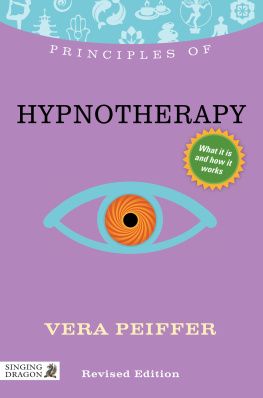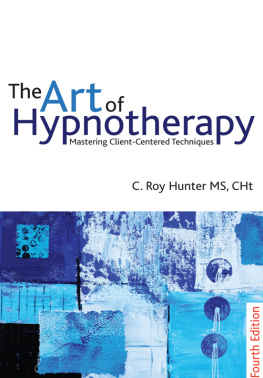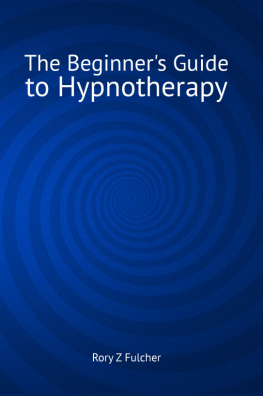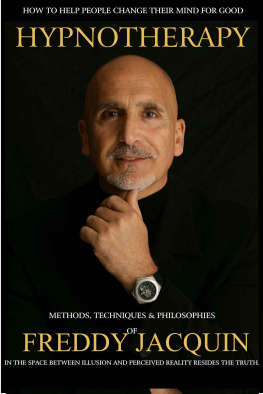
PRINCIPLES OF HYPNOTHERAPY
other titles in the series
PRINCIPLES OF
THE ALEXANDER TECHNIQUE
Jeremy Chance
PRINCIPLES OF
BACH FLOWER REMEDIES
Stefan Ball
PRINCIPLES OF
CHINESE HERBAL MEDICINE
John Hicks
PRINCIPLES OF
CHINESE MEDICINE
Angela Hicks
PRINCIPLES OF
THE ENNEAGRAM
Karen A. Webb
PRINCIPLES OF
KINESIOLOGY
Maggie La Tourelle with Anthea Courtenay
PRINCIPLES OF
NLP
Joseph OConnor and Ian McDermott
PRINCIPLES OF
REFLEXOLOGY
Nicola Hall
PRINCIPLES OF
REIKI
Kajsa Krishni Borng
PRINCIPLES OF
TIBETAN MEDICINE
Dr. Tamdin Sither Bradley
PRINCIPLES OF
HYPNOTHERAPY
What it is, how it works, and what it can do for you
Revised Edition
Vera Peiffer

LONDON AND PHILADELPHIA
This edition published in 2013
by Singing Dragon
an imprint of Jessica Kingsley Publishers
116 Pentonville Road
London N1 9JB, UK
and
400 Market Street, Suite 400
Philadelphia, PA 19106, USA
www.singingdragon.com
First published in 1996 by Thorsons, an imprint of HarperCollins Publishers
Copyright Vera Peiffer 1996, 2013
All rights reserved. No part of this publication may be reproduced in any material form (including photocopying or storing it in any medium by electronic means and whether or not transiently or incidentally to some other use of this publication) without the written permission of the copyright owner except in accordance with the provisions of the Copyright, Designs and Patents Act 1988 or under the terms of a licence issued by the Copyright Licensing Agency Ltd, Saffron House, 610 Kirby Street, London EC1N 8TS. Applications for the copyright owners written permission to reproduce any part of this publication should be addressed to the publisher.
Warning: The doing of an unauthorized act in relation to a copyright work may result in both a civil claim for damages and criminal prosecution.
Library of Congress Cataloging in Publication Data
A CIP catalog record for this book is available from the Library of Congress
British Library Cataloguing in Publication Data
A CIP catalogue record for this book is available from the British Library
ISBN 978 1 84819 126 6
eISBN 978 0 85701 102 2
For Ursula Markham with love and thanks for getting me started
Introduction
Complementary and alternative medicine (CAM) has grown rapidly over the last two decades and is now used by around six million people a year in the UK. As far back as the 1990s, the UKs Health Education Authority (HEA) commissioned a book which offered a general guide to complementary medicine and therapies, rating complementary therapies according to their popularity, their medical credibility, their scientific validity and their availability. Together with acupuncture and osteopathy, hypnotherapy achieved the highest rating in all four categories.
Despite its popularity and proven effectiveness, hypnotherapy has at times come into the spotlight in a negative way. Stage shows, sensationalist reports and the unethical conduct of a small number of therapists have added to the confusion that still exists about this ancient form of therapy. Even though most people nowadays have heard about hypnotherapy, general knowledge about the subject does not usually go beyond the use of suggestions to help people stop smoking or lose weight. Yet there is a lot more that hypnotherapy can do.
Principles of Hypnotherapy sums up scientific findings about hypnosis and explains how hypnosis is used to help with various conditions such as depression, anxiety, panic attacks, pain control, lack of confidence and many more. You will find clear descriptions not only of the workings of hypnotherapy, illustrated by case histories, but also a list of things you should look out for if you are thinking of visiting a hypnotherapist.
A whole section is devoted to False Memory Syndrome, and you will find advice on what questions to ask to avoid ending up with a practitioner who might lead you into false memories.
History and Development of Hypnosis
As a great number of ancient documents verify, hypnosis is one of the oldest therapies. Cuneiform writings that date back to four thousand years before Christ reveal that the Sumerians used hypnosis as a therapeutic tool. Specially trained priest-doctors gave sufferers hypnotic suggestions, as did the later Hindu fakirs, the Persian magi and the Indian yogi. The Ebers papyrus tells us that in ancient Egypt, priest-doctors would ask sufferers to fix their gaze on a glossy piece of metal to induce a hypnotic trance a precursor of the fixation technique (see page 106) which is still in use today in modern hypnotherapy.
The use of hypnotic suggestions for healing was employed all the way into the Middle Ages, but it was not until 1530 that an explanation other than divine intervention was offered for the cures achieved by hypnosis.
Paracelsus (14931541), a scientist and physician of Swiss origin, developed a theory about the interrelationship between the stars and human disease processes, and also about the magnetic powers man has over man. Later, Franz Anton Mesmer (17341815), an Austrian physician, developed the theory further by assuming that there was a universal fluid which enveloped and pervaded the earth and all human beings, and that the planets could bring about change in the human body through this invisible magnetic fluid. Mesmer named the fluid animal magnetism and suggested that disease or pain arose from an unbalanced distribution of this fluid in the sufferers body. He posited that magnets, with their power to attract and repel, could help rebalance this fluid. Healing by touch and healing by stroking were other methods used at the time, and Mesmer decided to combine all these measures in order to cure his patients. Mesmer would have his patients hold a piece of metal to the diseased or painful part of their bodies; and while they did so he would touch their bodies with a metal rod, claiming that this would redistribute the magnetic fluid and thereby facilitate a cure.
Mesmer was a charismatic man who set the scene for his patients by leading them into a darkened room where he would have music playing to create the appropriate atmosphere. In the middle of the room stood an oak tub filled with iron filings, powdered glass and water, from which emerged iron rods. Patients had to observe strict silence as they walked in and sat around the tub so that they could hold the metal rods while Mesmer made a dramatic entrance, cloak flowing, walking among the patients and occasionally touching one of them with his hand or his metal rod. During this process the patients would often show physical reactions such as coughing or convulsions. These reactions were called crises and were regarded as signs that healing was taking place.
Mesmer achieved spectacular results in many cases where conventional doctors had been unable to help. This angered his medical colleagues and he was forced to flee from Vienna to Paris, but his problems followed him there. Instigated by the medical profession, King Louis XVI ordered an investigation into animal magnetism. When no scientific proof could be found to explain the cures, this type of therapy was prohibited.
Even the mere discussion of the subject could lead to withdrawal of permission to practise as a doctor. Mesmers cures were consequently explained as being merely the result of his patients imagination. Mesmer had to stop practising and went back to his birthplace, where he died in 1815.
Next page












